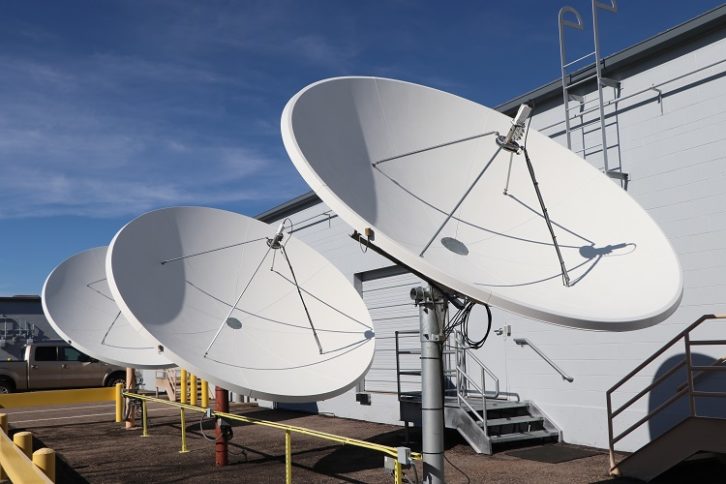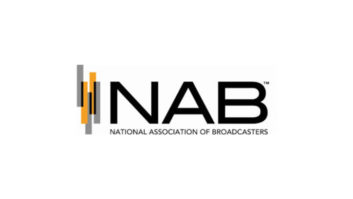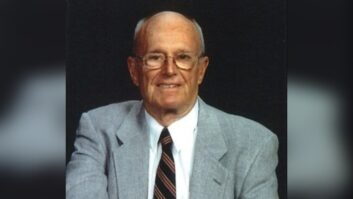
The complicated process of repacking C-band earth stations is underway in the United States, and radio broadcasters with receive dishes are managing the logistics and timing of their moves to mitigate possible interference.
As the country shifts C-band spectrum as part of a move toward national expansion of 5G, some satellite industry experts said a sense of urgency is developing and they urged broadcasters to order bandpass filters quickly to minimize disruptions.
C-band refers to frequencies in the 3.7 GHz to 4.2 GHz range. The spectrum has been used extensively for satellite downlinks, but those services are being repacked to the upper portion (4.0–4.2 GHz) of the band.
Observers say that if earth station licensees do not add the necessary filters — and replace small dishes where necessary — by the end of this year, 5G interference to satellite reception could start to be an issue in larger cities
That’s because Phase 1 of the satellite repack involves clearing satellite programming out of the lower 100 MHz of the band, 3.7–3.8 GHz, throughout 2021. After Dec. 5 of this year, 5G cellular transmitters will start to come online in that slice of spectrum in the most populous parts of the country. Satellite downlinks that aren’t equipped with appropriate filters could see their reception wiped out.
Phase 2 involves clearing satellite programming out of the lower 300 MHz of the band (3.7–4.0 GHz) throughout 2022 and 2023; and again 5G cellular transmitters will then turn on in that spectrum.

“Most radio stations can go straight to installing Phase 2 filters now, and at that point they will be done with the repack,” said John Joslin, director of sales and marketing at satellite hardware supplier Dawnco.
“The reason they can act now is that popular programs from Westwood One, Premiere, Learfield, NPR and Skyview are already above 4000 MHz and are within the bandpass of the Phase 2 filters. Stations should install the Phase 2 filter after the repack moves their programing above 4000 MHz, and thereby protect their downlinks from the coming 5G cellular interference.”
He said stations must also replace any mesh dishes as well as dishes with a diameter of less than 3.7 meters.
“The new Phase2 filters have significant attenuation, which will reduce EbNo numbers on satellite receivers,” he said. “Make an assessment to see if all of your sat antennas have 2 to 3 dB of signal quality margin, and replace those that do not with a larger dish.”
Taking their lumps
The FCC proceeding for C-band reallocation includes monies to reimburse earth station licensees for expenses to reconfigure earth stations to receive programming from the upper portion of the band. That could include modification and reconfiguration of dishes or possible relocation to prevent interference from new 5G cellular operating below 3980 MHz after December 2021 and below 4000 MHz after December 2023.
Approximately 1,500 earth station operators, some with multiple licenses, took the “lump sum” election, according the latest data from the FCC. Those licensees that did not accept that option can work with their satellite provider or recoup justifiable filter, dish and labor expenses direct from the Relocation Payment Clearinghouse, for expenses associated with the transition or relocation.
As of the end of April, the clearinghouse was expected soon to begin accepting applications for reimbursement on its website for registered downlink sites that did not file for the lump sum payment. One source indicated that would happen in mid-May, but FCC officials declined to comment on that.
The commission spokesperson said the clearinghouse has been working to set the procedures for processing reimbursement claims and for sending payments to entities that made lump sum elections.
“More details on this front will be announced as soon as possible,” the spokesperson said in April.
The clearinghouse is administered by accounting firm CohnReznick and law firm Squire Patton Boggs LLP. The FCC worked with RKF Engineering Solutions to develop its spectrum transition cost catalog, which sets reimbursement values for the work and hardware involved.
Across all users, including the radio industry, there are approximately 20,000 registered earth stations in the contiguous U.S. that are classified as incumbents for purposes of the C-band transition, according to the commission.
Satellite operators including SES and Intelsat have separate transition plans for their earth station customers. Those operators and others are eligible for billions of dollars in accelerated relocation incentive payments from the FCC to quickly move services to different frequencies.
[“SES Offers Some Answers to Radio’s C Band Questions,” Oct. 2020]
An SES spokesperson said about 40% of all of its earth station customers will be affected by the Phase 1 deadline in December.
Hardware concerns
One infrastructure insider told Radio World he anticipates there will be a bandpass filter shortage for earth station operators this year as the lump sum payments begin to arrive and orders for filters begin to flow.
“The two filter factories in the United States combined produce only 200 to 300 filters per week, and a last-minute burst of demand from hundreds of stations will cause high prices and long lead times,” the observer said.
“Large-market sites will stress when they are stuck in line waiting for their filter to arrive knowing that the interference begins in December. These new 5G services will cause interference for earth station operators who are not prepared.”
Radio broadcasters with downlink sites in major markets should begin planning for the transition if they haven’t already started, several experts said.
Public radio leases one C-band transponder on Intelsat’s Galaxy 16 satellite. National Public Radio was already working with satellite bandwidth provider Intelsat to designate a new transponder above 4 GHz for downlinks even before the repack process began, according to Michael Beach, vice president of distribution for NPR.
“Most of that work has been completed, which means some network infrastructure has already been updated in the past two years,” he said. “All the new PRSS receivers are now in place at every interconnected public radio station and the PRSS migration to new C-band frequencies is complete.”
Meanwhile, earth station filter installation is underway at many public radio stations across the country, Beach said. Each public station within the Public Radio Satellite System (PRSS) owns its own downlink equipment, according to NPR.
“This means that if they had a registered antenna on the FCC approved list, they were eligible to have Intelsat complete their filter installation, or opt out and receive the onetime payment from the FCC. Many of these stations told us that they have purchased a filter and installed it, had Intelsat install it for them, or have set up an appointment to have the work done,” Beach said.
Based on information from Intelsat, roughly 55% of eligible PRSS earth stations opted for Intelsat to install filters for them, and 45% selected the one-time lump sum payment option and will install the filters themselves, Beach said.
So far no repointing of antennas has been required of any public radio station since the PRSS remains on the same satellite using a transponder on the same polarity as its old signal, he said.
Networks prepare
Premiere Networks, a subsidiary of iHeartMedia, does not expect to have its operations disrupted by the C-band repack, according to Jeff Littlejohn, EVP of engineering for iHeartMedia. Premiere Networks operates in the portion of C-band spectrum that is not affected.
iHeartMedia radio stations, Littlejohn said, have a project underway to install filtering on all C-band dishes used by the broadcaster. “We expect the project to be completed in Q3 of this year,” he said.
iHeartMedia, the largest radio group in the United States, accepted the FCC’s lump sum option as reimbursement for expenses connected to reconfiguring its network of receive earth stations. It holds approximately 175 such licenses, according to the company.
Westwood One, which is owned by Cumulus Media, has worked for two years with the satellite providers to ensure a seamless change, according to Eric Wiler, senior VP of network technology and operations.
“Westwood One was already located above the 4000 MHz cutoff, so our transponders were always compatible with the new frequency allocation for satellite,” Wiler said.
“Overall, if an earth station is using a 3.8 meter (2 degree compliant) dish, with a current LNB, the Phase 2 (Blue) filters should mitigate the impact of 5G in most situations.”
Wiler said his biggest concern is with downlinks in the top 46 Partial Economic Areas that do not install new filters to shield from 5G interference by this December.
“While not every area will be saturated with 5G immediately in the first few days, ensuring filters are in place is the best proactive response stations may take,” he said.
“The C-Band Alliance did a lot of testing, including live-range testing, of these filer designs, demonstrating the effectiveness and preventing 5G signals from saturating the LNBs on earth stations.
“Westwood One is working with our Cumulus radio stations to install filters in advance of the December deadlines. Rather than focusing on only the top 46 PEAs, we’re filtering all our downlinks with the Phase 2 (blue) filters, as the major networks on SES-11 have already transitioned to our permanent frequencies.”
Unregistered users
There is still concern among some observers that a substantial number of small rural radio and television stations and private networks that rely on C-band programming may not have submitted registration filings for their downlink sites with the FCC and therefore are ineligible for compensation.
“We estimate that 20% of our broadcast and cable downlink customers did not register their dishes back in 2017 and 2018,” said Joslin of Dawnco.
“They didn’t hear about the registration drive, or they didn’t think it was important enough to pay the filing fee. Some stations may have to spend $5,000 to $15,000 to replace their dish if their old dish is susceptible to interference after the repack.”
The FCC has said there will not be another opportunity for earth station registration.
“As detailed in the C-band Report and Order, to qualify for cost reimbursement, an earth station must have met all relevant criteria to be considered incumbent for purposes of the C-band transition, including registration,” according to a commission spokesperson.
The redistribution of coveted C-band spectrum for next-gen 5G services has proven valuable for the United States. The FCC earlier this year announced final bid totals in Auction 107 of the C-band yielding nearly $81 billion. Cellco Partnership (Verizon) alone bid over $45 billion for approximately 3,500 licenses, according to FCC data. An AT&T led consortium paid over $23 billion for around 1,600 spectrum licenses.
It was the FCC’s most lucrative spectrum auction ever.
[Read more of Radio World’s recent C Band migration coverage.]












